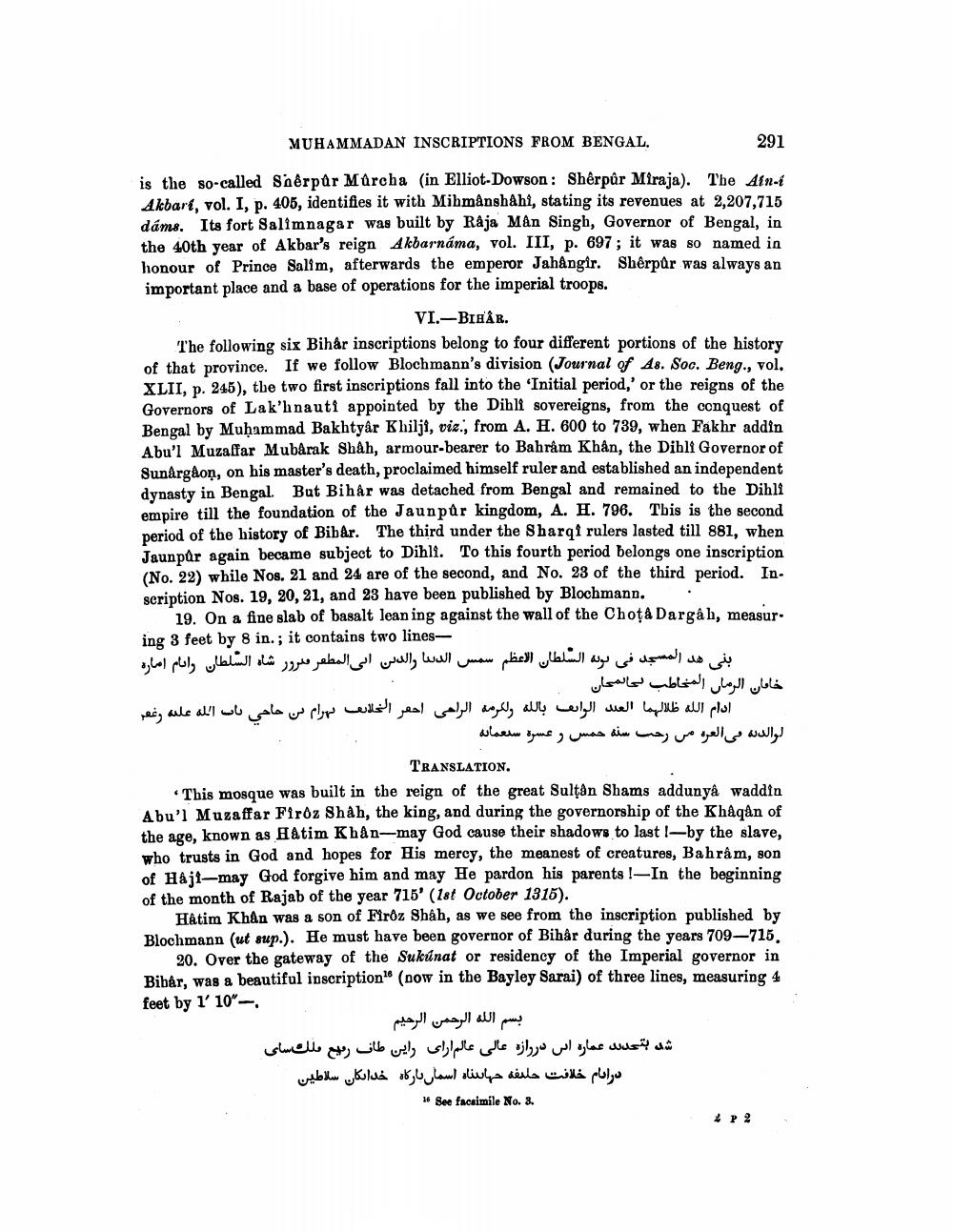________________
MUHAMMADAN INSCRIPTIONS FROM BENGAL.
291
vas built by hajaol an sing biso cover more of Bengala in
is the so-called Snêrpar Marcha (in Elliot-Dowson: Shêrpûr Miraja). The AinAkbari, vol. I, p. 405, identifies it with Mihmanshahi, stating its revenues at 3,207,715 dáms. Its fort Salimnagar was built by Raja Man Singh, Governor of Bengal, in the 40th year of Akbar's reign Akbarnáma, vol. III, p. 697; it was so named in honour of Prince Salim, afterwards the emperor Jahangir. Shêrpur was always an important place and a base of operations for the imperial troops.
VI.-BIBÂR. The following six Bihar inscriptions belong to four different portions of the history of that province. If we follow Blochmann's division (Journal of As. Soc. Beng., vol. XLII. p. 245), the two first inscriptions fall into the 'Initial period,' or the reigns of the Governors of Lak'hnauti appointed by the Dihli sovereigns, from the conquest of Bengal by Muhammad Bakhtyar Khilji, viz., from A. H. 600 to 739, when Fakhr addin Abu'l Muzaffar Mubarak Shah, armour-bearer to Bahram Khân, the Dibli Governor of Sunargaon, on his master's death, proclaimed himself ruler and established an independent dynasty in Bengal. But Bihår was detached from Bengal and remained to the Dihli empire till the foundation of the Jaunpur kingdom, A. H. 796. This is the second period of the history of Bibar. The third under the Sharqi rulers lasted till 881, when Jaunpr again became subject to Dihli. To this fourth period belongs one inscription (No. 22) while Nos. 21 and 24 are of the second, and No. 23 of the third period. In. scription Nos. 19, 20, 21, and 23 have been published by Blochmann. .
19. On a fine slab of basalt leaning against the wall of the Chota Dargah, measur. ing 3 feet by 8 in.; it contains two lines
الدنيا والدين الى المطعر ترور شاه الشلطان رانام اماره بنی هد المسجد في نودة السلطان الاعظم سمس خاقان الرمال المخاطب بالمعان
تاب الله عليه رغمر بهرام بن حاحی
أحمر الخلاب
بالله ولكرمه الراحی ادام الله ظلالهما العيد الوان لوالديه في العره من رحب سنه حمس وعسره سبعمایه
TRANSLATION. This mosque was built in the reign of the great Sultan Shams addunya waddin Abu'l Muzaffar Firoz Shah, the king, and during the governorship of the Khaqan of the age, known as Hatim Khån-may God cause their shadows to last 1-by the slave, who trusts in God and hopes for His mercy, the meanest of creatures, Bahram, son of Haji-may God forgive him and may He pardon his parents !-In the beginning of the month of Rajab of the year 715' (18t October 1315).
Hatim Khan was a son of Firoz Shah, as we see from the inscription published by Blochmann (ut sup.). He must have been governor of Bihår during the years 709-715.
20. Over the gateway of the Sukunat or residency of the Imperial governor in Bibâr, was a beautiful inscription" (now in the Bayley Sarai) of three lines, measuring 4 feet by 1' 10'
بسم الله الرحمن الرحيم
راین طان ربع ملك سای شده بتعدد عماره ایی دروازه عالی عالم ارای
درادام خلافت حلیفه جهادناه اسمال بارگاه خدادکان سلاطین
* See facsimile No. 3.




